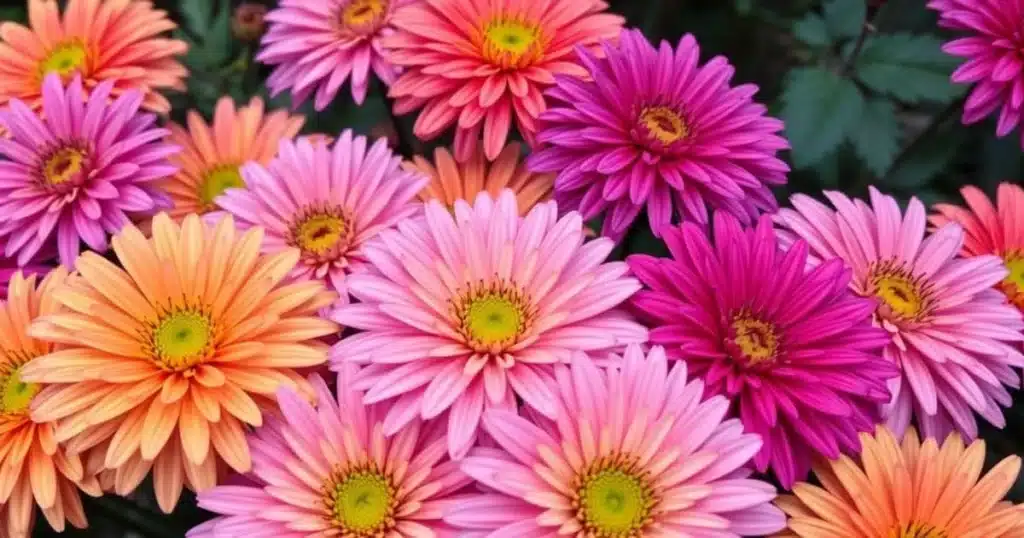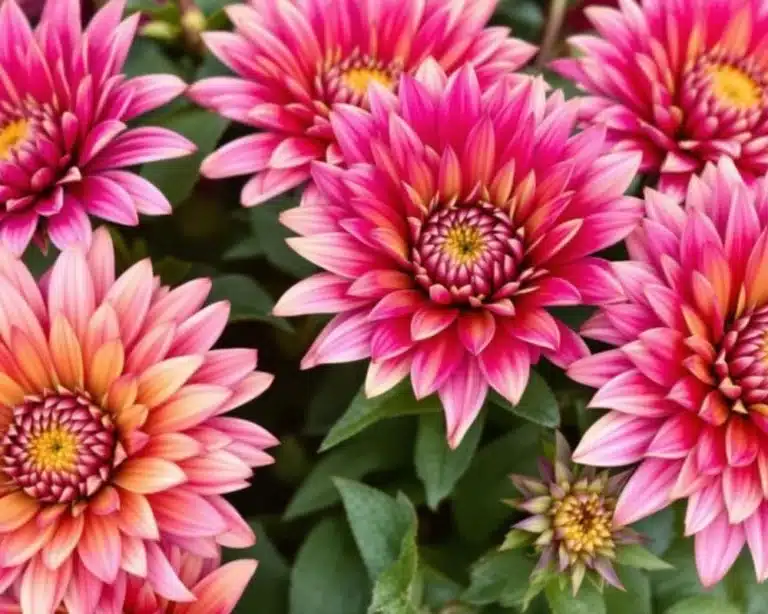Chrysanthemum morifolium, often just called mums, are those bright, cheerful flowers that pop up in gardens when most other blooms have called it a day for the season. They’re not just a fall staple; with the right care, these hardy perennials can grace your garden year after year. Whether you’re looking to add some late-season color or want to dive into the world of gardening, mums are a great starting point. From picking the right variety to making sure they survive the winter, there’s a bit to learn, but don’t worry, it’s all pretty straightforward.
Table of Contents
Understanding Chrysanthemum Morifolium Varieties

Popular Varieties and Their Characteristics
Chrysanthemum morifolium, commonly known as mums, come in a wide range of varieties, each with its own unique charm. These varieties differ in terms of flower color, bloom time, and even petal shape. Here are some popular ones:
- ‘Ruby Mound’: Known for its early-season bloom, this variety showcases large, maroon-red flowers. It’s a favorite for those who love deep, rich colors.
- ‘Patriot’: This cultivar offers mid- to late-season bloom with pure white, pompom-shaped flowers. It’s perfect for adding a touch of elegance.
- ‘Tripoli’: If you prefer vibrant pink with yellow centers, ‘Tripoli’ is a great choice. It blooms very late in the season, extending the color in your garden.
Choosing the Right Chrysanthemum for Your Garden
Selecting the right chrysanthemum cultivar for your garden depends on several factors, including your climate and the aromatic leaf of the plant. Consider the following:
- Climate Compatibility: Some varieties are more tolerant of heat or cold than others.
- Bloom Time: Decide if you want early, mid, or late-season blooms.
- Flower Color: Choose colors that complement your existing garden palette.
Seasonal Bloom Times and Colors
Chrysanthemums are celebrated for their seasonal blooms, which can range from summer to fall. The flower color spectrum includes white, yellow, orange, red, pink, and purple. This diversity allows gardeners to plan for continuous color in their landscape.
Chrysanthemums, with their varied bloom times and colors, can be a stunning addition to any garden. They not only fill in the gaps left by other fading plants but also bring a vibrant splash of color that lasts well into the fall.
Choosing the right variety can transform your garden into a colorful oasis, offering blooms when most other plants have ceased to flower.
Planting Chrysanthemum Morifolium for Optimal Growth

Selecting the Ideal Location
Choosing the right spot for your potted plant is key to its success. Chrysanthemums thrive in full sun, needing at least six hours of sunlight daily. Avoid areas with excessive shade, as this can lead to fewer blooms and weaker growth. Proper sunlight exposure ensures robust flowering and vibrant colors. Also, consider the plant’s exposure to wind, as strong gusts can damage the stems and flowers.
Preparing the Soil for Planting
The soil type plays a crucial role in the health of your chrysanthemums. Aim for well-drained soil enriched with organic matter. This helps retain moisture without becoming waterlogged, which can lead to root rot. A slightly acidic to neutral pH is ideal. Before planting, mix compost or well-rotted manure into the soil to provide essential nutrients.
Planting Techniques for Success
When planting, dig a hole twice the size of the root ball. This allows plenty of space for roots to spread. Space plants 18-30 inches apart to ensure good air circulation, reducing the risk of disease. If you’re planting in a container, make sure it has drainage holes to prevent water buildup. For bloom time considerations, plant chrysanthemums in the spring after the last frost, giving them ample time to establish before flowering in the fall.
Watering and Fertilizing Chrysanthemum Morifolium
Establishing a Watering Routine
Just like caring for lavender trees, providing the right amount of water and fertilizer is essential for mums to thrive. These plants thrive when their soil is kept evenly moist. Check the top inch of soil regularly, and once it feels dry, it’s time to water. If you’re growing mums in pots, make sure they have drainage holes. Water until it trickles out the bottom, ensuring the soil is moist but not soggy. Avoid letting the soil dry out completely, as this can stress the plant and affect its blooms.
Choosing the Right Fertilizer
Fertilizing mums is crucial during their growing season. Start with a balanced 20-10-20 fertilizer during planting and continue through the vegetative phase. This encourages robust growth and root development. Once established, switch to a 5-10-5 liquid fertilizer to support blooming. Remember, feeding should cease by mid-summer to prevent new growth from being damaged by frost.
Timing and Frequency of Fertilization
Timing your fertilization is key. Begin feeding after the last frost in spring to help your mums wake up from their winter dormancy. Apply fertilizer every 4-6 weeks during the growing season. Avoid fertilizing after July to protect new growth from early frost damage. This schedule helps ensure your mums are healthy and ready to produce vibrant blooms come fall.
Consistent care in watering and feeding your Chrysanthemum Morifolium will reward you with lush, beautiful blooms. Keep an eye on your plant’s needs, and adjust your routine as necessary to maintain their health and vitality.
Pruning and Maintaining Chrysanthemum Morifolium
Techniques for Pruning Mums
Pruning is a vital part of keeping your mums healthy and vibrant. Start by pinching back the stems when the plants are about six inches tall. This encourages bushier growth and more blooms. Repeat this pinching process every few weeks until midsummer. Avoid pruning too late in the season, as this can reduce the number of blooms.
Encouraging Bushier Growth
To get that full, lush look, regularly pinching is key. When your mums reach about a foot tall, pinch back the top inch of each stem. This simple action encourages the plant to branch out, leading to a bushier appearance. Additionally, make sure to space your plants properly to allow for adequate air circulation, which helps prevent disease.
Deadheading for Continuous Blooms
Deadheading, or removing spent flowers, is crucial for continuous blooming. As soon as a flower starts to fade, snip it off just above the next leaf set. This not only keeps your plant looking tidy but also redirects energy to producing new blooms. Regular deadheading can extend the flowering season, keeping your garden vibrant well into the fall.
Chrysanthemum Morifolium, often just called mums, can truly transform your garden with their vibrant colors and lush growth. With a little attention to pruning and maintenance, these plants will reward you with a stunning display season after season.
Protecting Chrysanthemum Morifolium from Pests and Diseases
Identifying Common Pests and Their Impact
Chrysanthemums, while generally hardy, can sometimes fall prey to pests like aphids, leafminers, and the notorious spider mite. These tiny insects can wreak havoc on your plants by sucking sap, leading to distorted leaves and stunted growth. Regularly inspecting your plants for these critters is key. If you notice any signs, consider using an insecticidal soap like the one used for Rhipsalis as an effective measure to control these pests.
Preventing and Treating Fungal Infections
Fungal diseases like powdery mildew and leaf spot are common issues for chrysanthemums. These diseases can cause unsightly spots and a white powdery coating on leaves, which can eventually lead to plant decline. To prevent these, ensure your mums have good air circulation and avoid overhead watering. If infection occurs, remove the affected parts and consider fungicidal treatments to keep the disease in check.
Maintaining Plant Health Through Proper Care
Keeping your chrysanthemums healthy is the best defense against pests and diseases. Here are a few tips:
- Water Wisely: Water at the base of the plant to keep foliage dry and reduce disease risk.
- Fertilize Regularly: Use a balanced fertilizer to support robust growth.
- Prune Prudently: Remove dead or diseased foliage promptly to prevent the spread of infections.
A healthy chrysanthemum is less likely to succumb to pest and disease pressures. With proper care and vigilance, your mums can thrive and bring vibrant color to your garden year after year.
Overwintering Chrysanthemum Morifolium
Preparing Mums for Winter
When winter approaches, it’s important to ready your perennial plant for the colder months. Begin by leaving the foliage intact until spring. This helps protect the plant’s crown. After the first frost, consider adding a layer of mulch around the base. This insulates the roots against frost heaving, which is common in a colder climate. For those in a warmer climate, less mulch is needed, but still beneficial.
Indoor Care for Potted Chrysanthemums
For potted mums, once the blooms fade, move them to a cool, well-lit area indoors. Remove any decorative wraps from the pot to allow for proper drainage. Water them sparingly, ensuring the soil is dry a couple of inches down before rewatering. This prevents waterlogging, which can be fatal. During winter, avoid placing them near night light sources as it can disrupt their rest period.
Spring Revival and Planting Tips
As winter wanes, gradually reintroduce your mums to the outdoors. Start by placing them in a sheltered spot with partial shade. Increase their exposure to outdoor conditions slowly to avoid shock. Once the risk of frost has passed, plant them in the garden. Use a bloom fertilizer to give them a nutrient boost. With the right care, your chrysanthemums will thrive and reward you with beautiful blooms year after year.
Overwintering mums might seem like a chore, but it’s a small price to pay for the vibrant color they bring to your garden. By taking just a few steps to protect them from the cold, you’ll ensure they return even more stunning than before.
Propagating Chrysanthemum Morifolium

Methods of Propagation: Seeds, Cuttings, and Division
Propagating Chrysanthemum Morifolium can be a rewarding experience. You can choose from seeds, cuttings, or division. Division is the quickest way to multiply your plants. It involves splitting mature plants into smaller sections. This should be done every three years to prevent root rot and maintain plant health. Cuttings, on the other hand, let you clone your favorite mum variety, ensuring you get the same beautiful chrysanthemum bloom with those stunning ray florets.
To learn more about plant propagation methods, including division, check out this detailed guide from Virginia Tech .
Best Practices for Successful Propagation
When dividing, choose plants that have been in the ground for at least two years. Dig them up in early spring, and carefully separate the roots. For cuttings, select a healthy stem, about 4 inches long. Remove the lower leaves and dip the cut end into a rooting hormone before planting in a well-draining medium. Keep the soil moist and place the container in a warm spot.
Timing and Conditions for Propagation
Spring is the ideal time for division as new growth appears. For cuttings, a warm, bright area is best, but avoid direct sunlight. Seeds can be a bit trickier but start them indoors during winter. Keep the temperature between 70-75°F for best results. Transplant seedlings after about a month, once they have a sturdy root system. Be mindful of the flower bud development, as this can indicate the best time to transplant outside.
Propagating mums is not just about increasing your garden’s beauty, but also about learning the art of plant care. Whether you choose seeds, cuttings, or division, each method has its own charm and challenges. With patience and practice, you’ll have a garden full of vibrant mums.
Enhancing Your Garden with Chrysanthemum Morifolium
Designing with Chrysanthemums: Color and Layout
Chrysanthemums, or “garden mums,” are a gardener’s dream when it comes to adding a splash of color to your garden. These plants come in a variety of hues, including vibrant yellows, deep reds, and soft pinks, making them perfect for any garden design. Arranging chrysanthemums by color can create a stunning visual effect. For instance, placing bright yellow mums next to deep purple ones can create a striking contrast that draws the eye. Consider a layout that alternates colors or forms a gradient from light to dark shades.
Companion Planting for Visual Appeal
Companion planting is a smart way to enhance your garden’s beauty and health. When pairing garden mums with other plants, consider those that bloom at different times to ensure continuous color throughout the seasons. Some great companions for chrysanthemums include:
- Lavender: Its soft purple flowers complement the bold colors of mums.
- Ornamental grasses: Their texture provides a nice contrast to the dense mum blooms.
- Asters: These share similar growing conditions and can fill in gaps when mums are not in bloom.
Incorporating Mums into Seasonal Decor
Chrysanthemums are not just for the garden; they make excellent additions to seasonal decor. During fall, use potted mums to adorn your porch or patio. Pair them with pumpkins and gourds for a classic autumn look. Indoors, mums can brighten up any space. Place them in decorative pots or baskets to bring a touch of nature inside. Remember, while they are beautiful, they are also toxic to pets, so keep them out of reach of curious animals.
Chrysanthemums are more than just a plant; they are a versatile element in garden design and home decor. Their ability to adapt to various settings makes them a favorite among gardeners and decorators alike.
Conclusion
Taking care of Chrysanthemum morifolium, or mums, can be a rewarding experience, bringing vibrant colors to your garden well into the fall. With the right planting time, a bit of attention to soil, water, and light, these hardy plants can thrive and bloom beautifully. Remember to keep an eye out for pests and diseases, and don’t forget to pinch and deadhead for more blooms. Whether you’re growing them in pots or directly in the ground, mums can be a stunning addition to any garden. So, roll up your sleeves, get your hands dirty, and enjoy the beauty these flowers bring to your outdoor space.
Frequently Asked Questions
How do I choose the best spot for planting chrysanthemums?
Chrysanthemums love sunny places. They need lots of sunlight to grow well. Try to avoid planting them near street lights because too much light at night can confuse them.
How often should I water my chrysanthemums?
Water your chrysanthemums when the top inch of the soil feels dry. Be careful not to overwater them because soggy soil can harm the roots.
What should I do if my chrysanthemums’ leaves turn yellow?
Yellow leaves might mean the plant is getting too much water. It could also be a sign of pests like leafminers. Make sure to water properly and check for bugs.
Can I grow chrysanthemums indoors during the winter?
Yes, you can keep chrysanthemums in pots indoors during winter. Place them in a cool, bright spot and water them when the soil feels dry.
How do I make my chrysanthemums bushier?
To encourage bushier growth, pinch the tips of the branches when they are about 6 inches tall. This helps the plant grow more branches and flowers.
Are chrysanthemums safe for pets?
No, chrysanthemums are toxic to pets like dogs, cats, and horses. Keep them out of reach to ensure your pets stay safe.


2 thoughts on “Chrysanthemum Morifolium: Top Tips for Growing Mums”